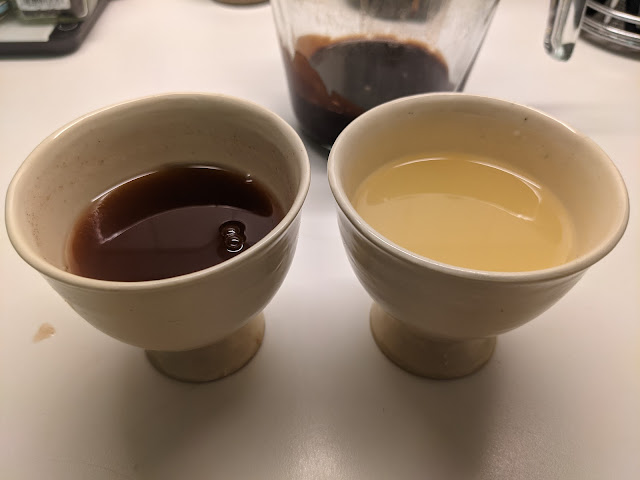A while ago I
translated this recipe, and now that I've made it a few times, it's time to give you a readable recipe.
Ingredients:
- Two parts dry glutinous (sticky) rice, divided into two equal parts.
- 0.1 parts yeast cakes (ideally white cloudy wine yeast cakes, as of yet untranslated)
Steps:
- Thoroughly rinse half the rice, strain it, and put it, uncooked, in your fermenter.
- Bring 1-2 parts water to a boil, and pour it over the rice until the rice is covered.
- Cover the fermenter with a clean cloth.
- The next day, strain out the rice, retaining the liquid.
- Steam the rice, and spread it to cool.
- While you steam the rice, take 0.2 parts of the liquid retained from the rice, and boil it down to 0.05 parts. Cool it, beat it with a whisk until frothy, and put it in your fermenter.
- Put the cooled rice, and 0.06 parts water in the fermenter.
- Powder the yeast cakes and put them in the fermenter, and mix.
- Cover the fermenter with a clean cloth.
- The next day, strain out the liquid from the mash. Discard the mash, and return the liquid to the fermenter.
- Steam the second half of the rice, and add it, hot, to the fermenter.
- Cover the fermenter with a clean cloth.
- After 1-4 days, the wine should be finished.
One "part" here is 30L in the original recipe, and it also says to not scale beyond that in a single fermenter.
This recipe produces a somewhat thick, sweet, opaque white wine. It's actually quite nice!
The process is actually somewhat similar to sake making: the liquid you drain off from the first batch of rice is full of amylase and sugar, which will help to ferment the second batch.
Pictures:
 |
| Steeping the rice in boiling water |
 |
| Steamed, boiled rice. |
 |
| Into the fermenter! |
 |
| After fermenting. It's very moldy, but this happens every time so I suppose it's intentional |
 |
| Straining out the sugar + amylase |
 |
| Steaming more rice. My rice steaming game needs work. |
 |
| Adding back the liquor |
 |
| I was worried the high temperature would damage the yeast and the amylase... |
 |
| But actually it worked out to 108 degrees, which is just about perfect for yeast growth. |
I don't have pictures of the finished product. The first time I made this (for the Feast of John Barleycorn), it came out with a very thick texture, but I think that must have been a one-off problem because the second batch was only slightly thick, and much sweeter. That suggests to me that the amylase didn't do its job the first time.












Comments
Post a Comment